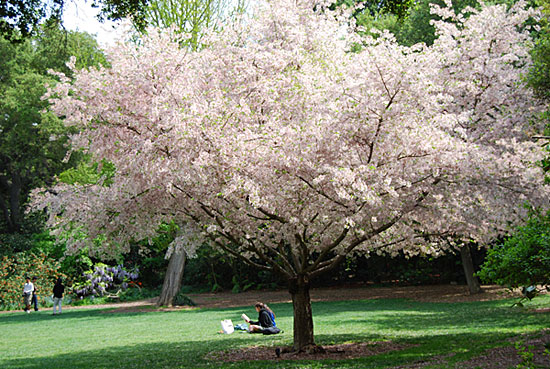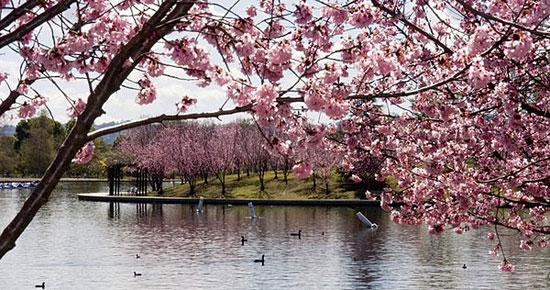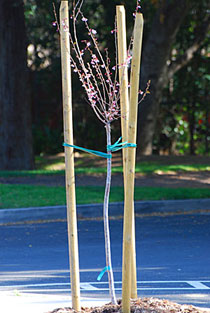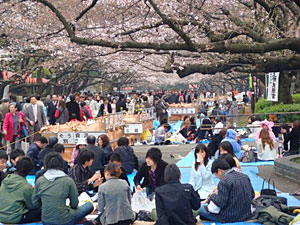
Cherry blossoms at Descanso Gardens in La Cañada Flintridge, where a festival will be held this weekend.
It’s cherry blossom time again, and not just in Washington, D.C.
Southern California will be showered with more delicate pink petals than ever this year, as the region helps observe the 100-year anniversary of a goodwill gesture that turned our nation’s capitol into a blossoming, seasonal Mecca—a 1912 gift from Tokyo of more than 3,000 ornamental cherry trees.
At least a dozen local Cherry Blossom festivals have been scheduled, and trees have been planted from Los Angeles’ Roosevelt High School to Griffith Park. Meanwhile, in May, about 18 saplings will be planted in the new 12-acre Civic Park that’s being developed between City Hall and the Music Center. Embracing the spirit of a century ago, the Japanese Consulate in Los Angeles helped coordinate the donation of most of the region’s new trees through non-profit groups.
“Cherry blossom trees are a living testament to the friendship between Japan and the United States,” says Jun Niimi, Consul General of Japan in Los Angeles.
Elegant and evanescent, Japanese cherry blossom trees, or sakura, are a beloved sign of spring in that country. Few experiences are as dreamlike as the traditional picnic under a cherry tree in full bloom, as leafless boughs create clouds of pale blossoms and petals float on the wind.
The trees took hold in this country early in the 20th century, after Eliza Scidmore, a Washington socialite and travel writer, experienced them in Japan during a trip with her diplomat brother, and returned in 1885 with the notion that they should be planted on reclaimed parkland along the Potomac River.
The National Park Service has the full history, but the shorter version is that for the next 20-plus years, she unsuccessfully lobbied five presidential administrations. Finally, after an official from the U.S. Department of Agriculture proved the trees could survive here, Scidmore caught the attention of First Lady Helen “Nellie” Taft, who had visited Japan while her husband was governor-general of the Philippines during the McKinley Administration. The First Lady got 90 cherry trees planted along the Potomac, then accepted a donation from the Japanese government for thousands more saplings. Although pests infested the first shipment, nearly causing a diplomatic incident, the Japanese followed up with a new donation, and 3,020 cherry trees arrived by rail in Washington,D.C., on March 26, 1912.
By the 1930s, Japan-U.S. tree exchanges had spread throughout the country. In 1933, Los Angeles papers reported that the Japanese Chamber of Commerce was “strengthening the bond of friendship between America and Japan” by seeding Griffith Park with 375 cherry trees.
In 1941, four of the Washington, D.C., trees were vandalized after the Japanese attack on Pearl Harbor, but they generally remained a positive symbol. In fact, the largest stand in Los Angeles County was the result of international goodwill, albeit of the corporate variety. In 1990 and 2009, the Canare Corp., a Japan-based cable manufacturer, donated a total of more than 1,000 cherry trees to Los Angeles to plant at Lake Balboa in the Sepulveda Basin.
“They had an office in the San Fernando Valley and wanted to give back to the city,” recalls James Ward, who at the time was in charge of the maintenance division of the Los Angeles Department of Recreation and Parks. “They even sent some of us back to learn how the Japanese maintain the trees.”
The saplings being donated in Southern California this year have come mainly from two programs, one local, one national.
Locally, the Huntington Botanical Gardens in San Marino made about 1,000 cherry trees available earlier this year to cities and civic groups throughout the region; the trees were mostly of the “Pink Cloud” variety, a unique West Coast hybrid that appeared as a volunteer seedling at the gardens in the 1960s. Nationally, the National Arbor Day Foundation, American Forests, the Japanese Embassy and a variety of Japan-America organizations have joined in a Nationwide Cherry Blossom Tree Planting Initiative to plant some 2,000 more trees.
Of course, beauty has its price. Frank McDonough, botanical information consultant at the Los Angeles County Arboretum & Botanic Garden notes that, except for the Pink Clouds and a few other varieties, the trees aren’t a natural fit in toasty L.A..
“They’re terrible for the landscape, they’re heavy water users and if they don’t get the drainage they like, they’ll leave you.”
But he adds: “People like them—they’re sentimental. And they’re pretty spectacular while they’re here.”

The area’s largest stand of cherry trees is at Lake Balboa in Van Nuys, seen here in an earlier year.
Posted 3/21/12








